|
|
Post by sixshot on Dec 11, 2015 13:22:50 GMT -5
When I was a young rooster living in Sherman, Texas i always wanted to stop in & see Ed Shilen when he was in Irving but never made it. I've used several of his barrels over the years & they were always better than I was. Can't remember the bench rest home of famer that always wore the funny looking hat but he always swore by Shilen barrels. We lost a good one!
Dick
|
|
|
|
Post by Lee Martin on Dec 16, 2015 19:30:21 GMT -5
Cutting Groups – Part VIII ________________________________ Saturday dealt the type of humidity change I’ve been after. Unseasonably warm temps hit the east coast along with moist morning air. At 9:00 AM it was already 59 degrees and humid (~80%). I began with 28.3 grains shooting over flags which barely flickered. The first group measured a disappointing 0.318”. I then adjusted the Culver down one click to 28.0 grs. Conditions held as did the calm wind. Group #2, fired 17 minutes later, went 0.174”. Group #1 – 28.3 grs LT-32 (51.5 Culver)  Group #2 – 28.0 grs LT-32 (51.0 Culver) 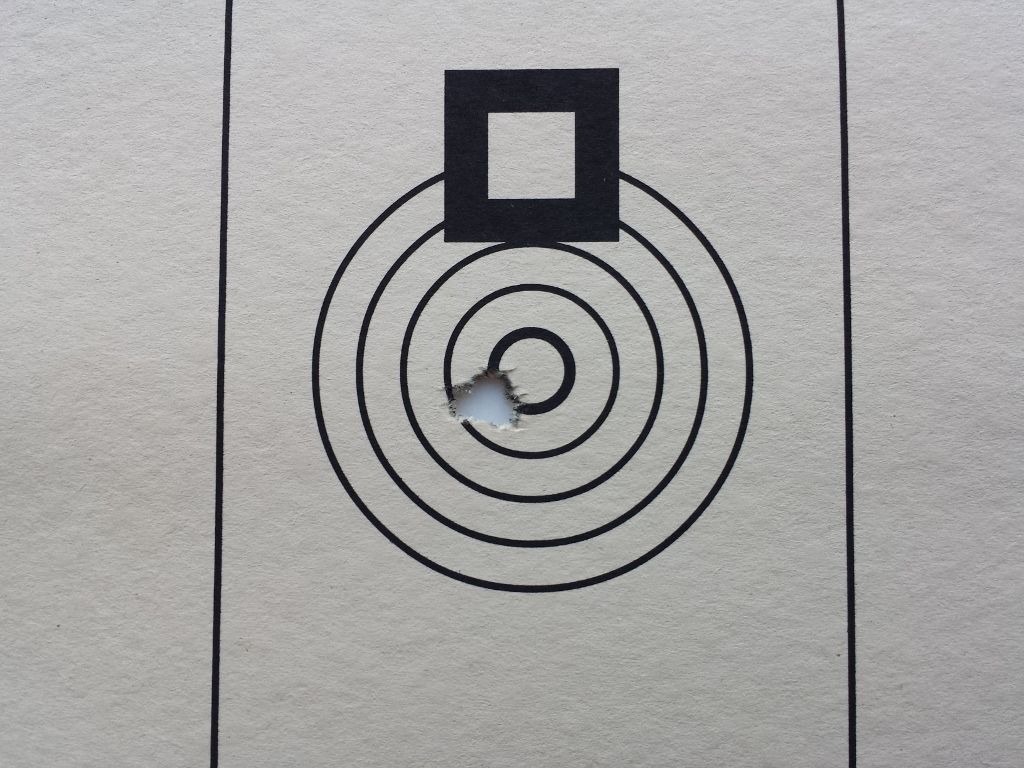 70%+ humidity stuck around until 10:30 and 28.0 shot tight. As it warmed and moisture burned off I dialed 28.3. And sure enough my targets proved the barrel was back on a node. The next six averaged 0.225” and one flirted with a zero: 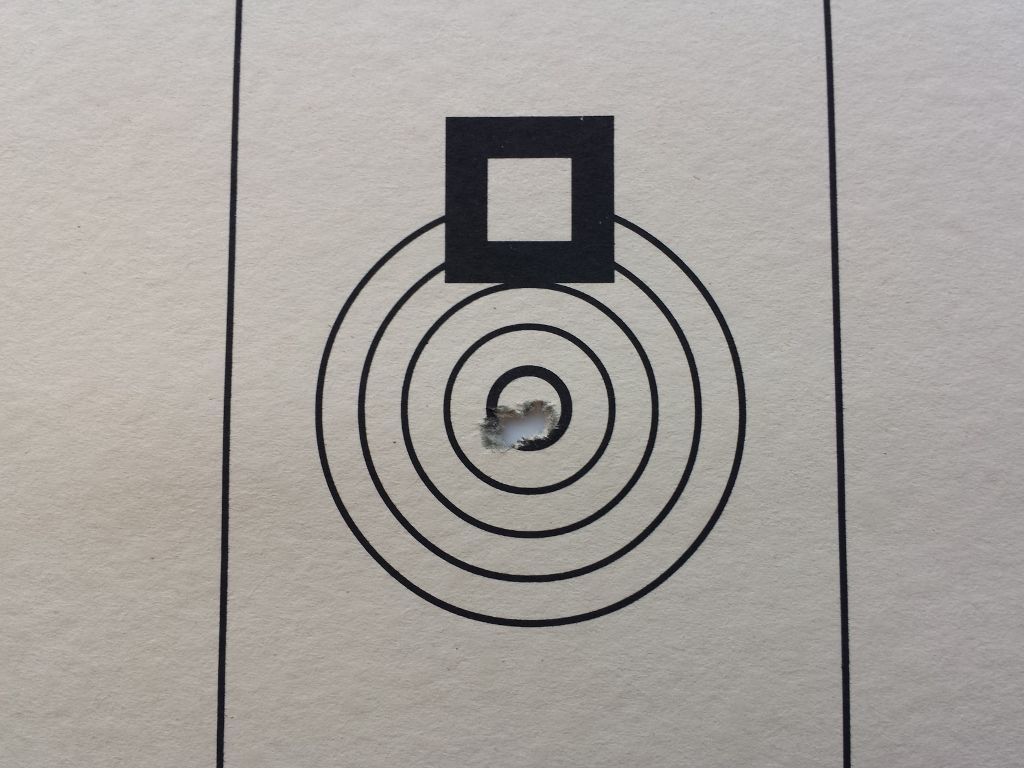 1 - 3 went in the same hole, 4 walked right due to a wind shift, and 5 snapped back. On the whole it measured a respectable 0.233” (would've been low teens or better had the fourth not strayed). I still have a lot to learn about LT-32 and humidity. Below 60% it seems to want 27.7 and 28.3. 70% or higher shows promise at 28.0. Between those ends is no man’s land...at least for now. I'll try again this weekend with a freshly Iosso’d bore and colder weather. More to come. -Lee www.singleactions.com"Chasing perfection five shots at a time" |
|
|
|
Post by Markbo on Dec 20, 2015 20:03:16 GMT -5
Lee I am sure you have said but I dont remember...what scope are you using?
|
|
|
|
Post by Lee Martin on Dec 21, 2015 19:36:24 GMT -5
Lee I am sure you have said but I dont remember...what scope are you using? Markbo – the scope is a 40x March; fine cross hair reticle with a 3/32” dot. Another thing I’ve been meaning to illustrate is the size of a BR-100 target. They’re much smaller than they appear in the above photos. Center mothballs are just 1/2” outer edge-to-outer edge. The second ring is 1” across. To put that in perspective, if you stick 5 in the middle circle the group is 0.257” max (0.500” minus 0.243”). Sounds impressive but in competitive benchrest that’s loafing.   I’m shooting the PPC this Wednesday and Thursday. They’re forecasting warm temps, wind, and rain each day which will present a challenge. Hopefully I can learn more about LT-32 in high humidity. -Lee www.singleactions.com"Chasing perfection five shots at a time" |
|
|
|
Post by Lee Martin on Jan 5, 2016 19:24:40 GMT -5
Cutting Groups – Part IX ______________________________ It rained like hell the two days before Christmas. Exactly the type of weather I needed to further test LT-32 in high humidity. Group #1 was fired on the lower 27.7 gr node. The gun went off tune and the results were glob-like. • Time – 9:04 AM • Temp = 60.3, humidity = 94.6% • 27.7 grs of LT-32, Lot #6 (50.5 Culver measure) • Velocity – TBD • 68 grain FB Bart’s Ultra • Seating – touch / slightly in (#42 Sinclair seater) • Brass – Lapua, 13th firing • 0.0015” neck tension – 0.261” bushing • CCI BR-4 primer • Shoulder bump = 0.001” • Loaded neck = 0.2625” on a 0.264” chamber. 0.0015” clearance  Size: 0.529” – 0.243” = 0.286”.  I wasn’t happy with this over silent flags. The Culver was then adjusted up a click to 51.0 or 28.0 grs. Group #2 was shot 23 minutes later through the same wind, or lack thereof. • Time – 9:29 AM • Temp = 61.8, humidity = 95.2% • 28.0 grs of LT-32, Lot #6 (51.0 Culver measure) • Velocity – TBD • 68 grain FB Bart’s Ultra • Seating – touch / slightly in (#42 Sinclair seater) • Brass – Lapua, 13th firing • 0.0015” neck tension – 0.261” bushing • CCI BR-4 primer • Shoulder bump = 0.001” • Loaded neck = 0.2625” on a 0.264” chamber. 0.0015” clearance  Size: 0.382” – 0.243” = 0.139”  What gives? I’m not sure anyone knows for certain but here’s a theory. Damp air allows moisture to get in-between the powder granules. Generally speaking smokeless is hydroscopic so it really doesn’t absorb water. Instead it ‘adsorbs’ it, trapping H20 molecules within the charge volume. Another way to think of this is the moisture binds or holds the kernels together. This water may or may not compete with the burn agent when ignited. But we do know if you humidify powder and immediately weigh it’ll be heavy. Let the same charge sit in a dry place for an extended period and it’ll scale less. Secondly, controlled tests prove damp powder lowers velocity. I suspect some of the ignition is used to burn off this vapor. Or perhaps moisture does affect how the granules combust. Either way this adsorption happens fast. No matter how prudent you are in filling the hopper or case it’s unavoidable. To date I haven’t chronographed my PPC. Most benchresters aren’t interested in pinpointing velocity or the associated spreads. The target dictates the node, not absolute feet-per-second. In fact many nodes show higher extreme spreads than out of tune combinations. Beyond 300 yards guys pay closer attention to that variable but in short-range it’s noise. So if humidity drops speed and increases barrel time the rifle can bounce off node. To re-land a tip (ie, the point of slowest deflection) we alter the charge. I added 0.3 and left it up to the target. You’ll see above how 28.0 cut the group in half. I shot six others at the 51.0 setting and agg’d 0.217”. Last Saturday dealt much different conditions. Temperature was 40 degrees and humidity averaged 36%. I started with 28.0 grs and got a 0.342”. Horrible because everything else clicked (bag tracking, flag reads, reticle hold, trigger touch, and so forth). I went back to 27.7 and the next measured 0.197”. Total aggregate for the day was 0.239”. This suggests LT-32 is sensitive to big changes in humidity. But the tune window seems narrow. 0.3 grs to be exact. Side-note: after 700 rounds my jam length increased 0.007”. Before each outing I test this by seating long and cycling. Adjusting my Sinclair upper allows me to stay at touch or just slightly “in”. If you recall the stem began at #35. To compensate for seven-thousandths in lead wash I’m now seating on #42. Rain is forecasted for Saturday morning so I’ll take another stab at wet air. -Lee www.singleactions.com"Chasing perfection five shots at a time" |
|
|
|
Post by Lee Martin on Jan 6, 2016 19:58:27 GMT -5
Rifle Maintenance __________________________ There are plenty of maintenance tasks to consider beyond normal cleaning. I’ll start by sharing the phrase ‘accuracy gremlins’. It isn’t uncommon in benchrest, or any shooting discipline, to experience drops in performance. One day your rig is on, the next it patterns like a 12 gauge. Causes include barrels dying, optical POA shifts, eye piece lock rings loosening, and hard carbon fouling. More unnerving are changes in the rifle’s bedding. On occasion pillars tweak and adhesion weakens on glue-ins. These two kill groups as quick as the other four combined. Scope attachment - countless stories have been told about guys blowing aggs for loose scope hardware. PPC’s don’t recoil much but they vibrate enough to undo ring and base screws after prolonged use. So every 50 – 100 rounds I check the following: Remove the scope and re-tighten the dovetail screws. Loctite helps but isn’t an end-all:  Test the ring side mounts. I’ve positioned the front edge of the lead ring just behind base screw #1. A quick glance tells me if it has moved: 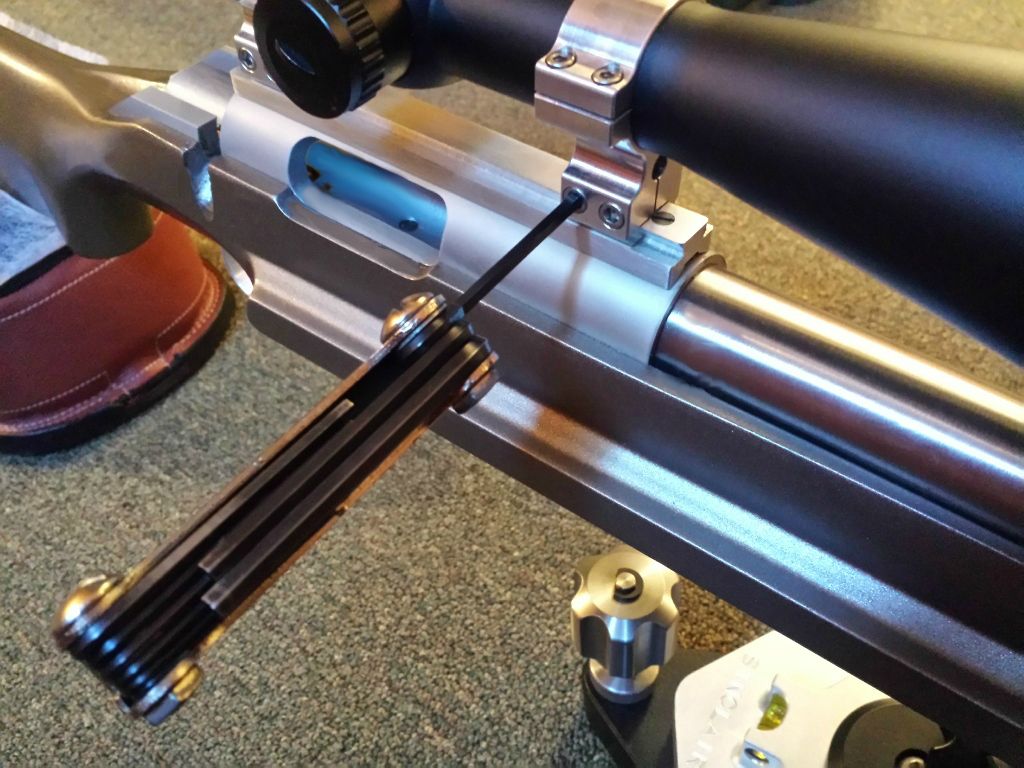 Firm the cap screws: 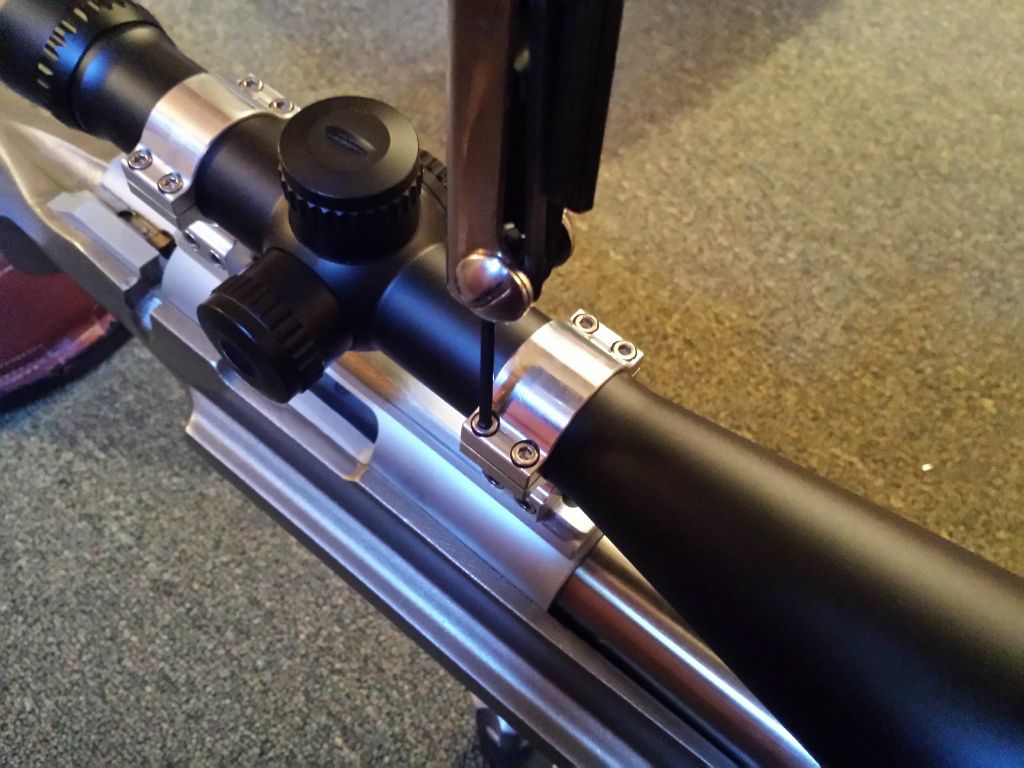 Equally important are the main action bolts. Mine are applied at 30 in-lbs and using a Felo torque driver I routinely check them: 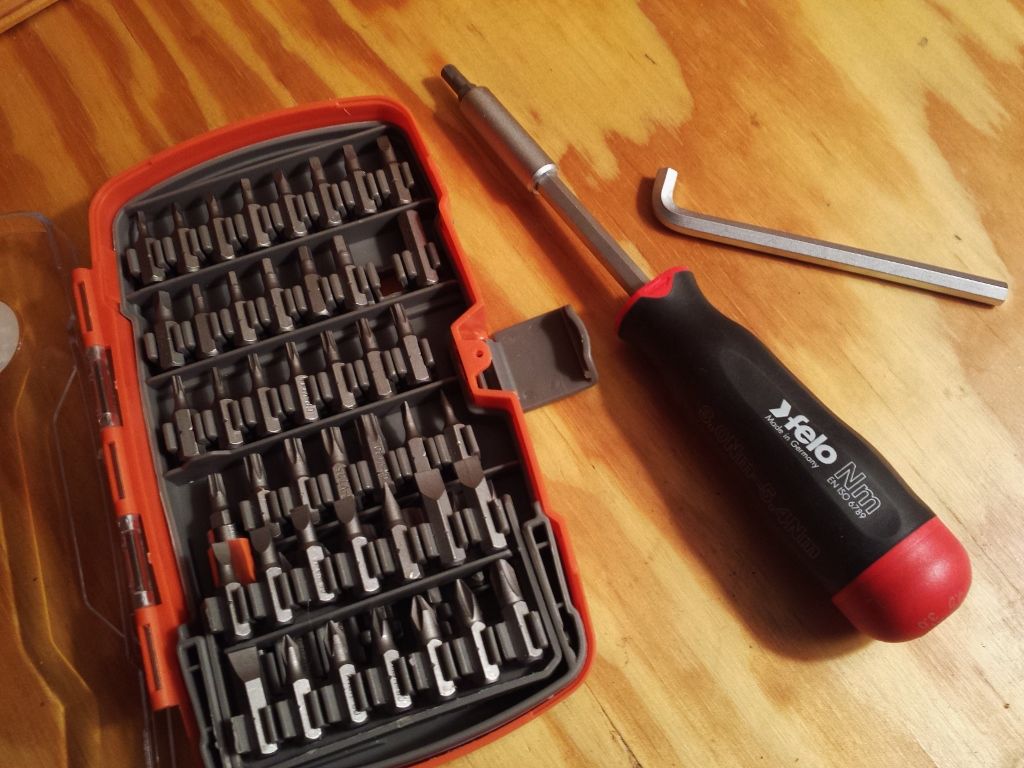 Note - Felo’s are German made and come calibrated for newton-meters. The thirteen increments span 26 to 48 in-lbs. For example, 3.2 = 30 in-lbs. These are reasonably priced and work beautifully for light fastening.  -Lee www.singleactions.com"Chasing perfection five shots at a time" |
|
|
|
Post by bradshaw on Jan 7, 2016 7:27:34 GMT -5
Lee.... The combustion issues you raise----humidity, moisture between propellant granules, burn progression, departure moment in relation to vibration node----may not be linear. Chemistry and physics are not the tea of a sharpshooter, steering the plane is, yet our bullets are bound by the alchemy between mind and target.
Your current shooting with wind flags slack steps in the tracks of bench shooting indoors, where wind is eliminated, while atmospheric variables continue.
David Bradshaw
|
|
|
|
Post by cherokeetracker on Jan 7, 2016 12:26:31 GMT -5
The conditions with the Humidity and moisture Seem to have a bearing to some degree. But my question is can we go back to the notes, and compare Barometric Pressures? This has been such a great learning tool, and with all the wealth of information along with photos makes it even better. Two of the things that David mentioned got me to really thinking about the Barometric pressure being more of a culprit to the accuracy than Humidity. 1. was the steering of the Plane. Anyone who pilots a fixed wing would know what I mean. 2. The other is Indoor shooting. Let's say we load the ammo in the controlled or near sterile environment, and with the (Air conditioning ) we have the near constant humidity and temperature. Oh and 0 wind of course. As we now have sought to eliminate or perfect the conditions of any Gremlins, with our Indoor Range. Where does this leave us with the Barometric Pressure? I believe that is still left unchanged with it being from an outside source. And outdoors will of course, it will change sometimes often. Like David said : Atmospheric variables continue.
Perhaps this was to be the next segment of your Thread,, if so forgive the jump ahead. And if Altitude can be another chapter that will be additional fun.
Charles
|
|
joej
.30 Stingray
 Enter your message here...
Enter your message here...
Posts: 352
|
Post by joej on Jan 7, 2016 12:30:46 GMT -5
Sometimes just a slight difference in seating depth can change mid to low 0.2's into low to mid 0.1's. Just head on down to Kelbly's this coming May and give those boys a run for their money.
|
|
|
|
Post by Lee Martin on Jan 13, 2016 19:44:17 GMT -5
A glimpse into a benchrest event. This one was shot in Sweden: You’ll notice the third shooter is using a frozen Leupold Comp on a Bukys base. __________________ The most decorated short-range shooter of all-time. Tony Boyer in 2010: I believe Tony took two or three different loads to the line. He probably tried a couple on the sighter, figured out what the gun wanted in those conditions, and moved to the record. You’ll also see how he runs his shots. Most likely got a stable flag read and sent five in succession. -Lee www.singleactions.com"Chasing perfection five shots at a time" |
|
|
|
Post by Lee Martin on Jan 13, 2016 19:54:04 GMT -5
The conditions with the Humidity and moisture Seem to have a bearing to some degree. But my question is can we go back to the notes, and compare Barometric Pressures? - Charles Charles – I tune my gun to temperature and humidity as standalone inputs; largely because that’s how my friend and I dial our drag car. But you’re right, barometric pressure, or even better density altitude are other ways to map. DA is probably more common than barometric because it measures air density given as height above mean sea level. Density altitude is derived by: DA = Ts/T *[1-((P/Ps)/(T/Ts))^((r*R)/((g*M) – ((g*M) – (r*R))] Where: Ts = standard sea level temperature T = static air temperature Ps = standard sea level atmospheric pressure P = static atmospheric pressure r = the lapse rate of 0.0065 K/m R = gas constant of 8.31432 J/mol·K g = gravity M = molar mass Fun looking equation, ehh? Luckily we have instruments that record DA so we avoid all the math. It is telling however. DA increases as temperature rises, pressure drops, and humidity moves up. Thus hot, humid air makes the density altitude higher than the true altitude relative to sea level. So what does this mean for bullets in flight? If DA increases the bullet speeds up for a given load. That’s because the bullet experiences thinner air, or higher imparted altitude. If DA drops the bullet slows down. Real world shooting supports this postulate. Remember earlier how I talked about lowering the charge as temperature rises? I know a lot of this seems over the top and unnecessary. And for the casual shooter it is. Yet in competitive BR we cling to these theories. Very few benchresters stick with the same load throughout an event; be that a weekend or a single day. The target tells you why. Even in my limited shooting I’ve had loads that print dots in the morning when the air is cool and moist. Then by mid-day the temperature rises 20 degrees, the humidity burns off, and the gun jumps tune. Higher temperatures at set humidity boosts velocity. Higher humidity at set temperature slows the bullet. The two can be a partial wash if using DA alone (note – when it rains all that goes out the door. Temperature can rise and humidity simultaneously spikes). Because of this I prefer dialing to each in isolation. Of course many guys far more accomplished than me use barometric pressure or DA, meaning they track one input. Really there’s no correct way to calibrate. The important thing is to stick with a baseline and alter your loads accordingly. That’s what truly separates the best from average benchrest shooters. It isn’t all about equipment. To be near the top you must keep the gun in tune and accurately read wind flags. -Lee www.singleactions.com"Chasing perfection five shots at a time" |
|
ericp
.327 Meteor
 
Posts: 522
|
Post by ericp on Jan 13, 2016 21:35:54 GMT -5
Absolutely fascinating.
Eric
|
|
|
|
Post by cherokeetracker on Jan 14, 2016 15:31:00 GMT -5
The conditions with the Humidity and moisture Seem to have a bearing to some degree. But my question is can we go back to the notes, and compare Barometric Pressures? - Charles Charles – I tune my gun to temperature and humidity as standalone inputs; largely because that’s how my friend and I dial our drag car. But you’re right, barometric pressure, or even better density altitude are other ways to map. DA is probably more common than barometric because it measures air density given as height above mean sea level. Density altitude is derived by: DA = Ts/T *[1-((P/Ps)/(T/Ts))^((r*R)/((g*M) – ((g*M) – (r*R))] Where: Ts = standard sea level temperature T = static air temperature Ps = standard sea level atmospheric pressure P = static atmospheric pressure r = the lapse rate of 0.0065 K/m R = gas constant of 8.31432 J/mol·K g = gravity M = molar mass Fun looking equation, ehh? Luckily we have instruments that record DA so we avoid all the math. It is telling however. DA increases as temperature rises, pressure drops, and humidity moves up. Thus hot, humid air makes the density altitude higher than the true altitude relative to sea level. So what does this mean for bullets in flight? If DA increases the bullet speeds up for a given load. That’s because the bullet experiences thinner air, or higher imparted altitude. If DA drops the bullet slows down. Real world shooting supports this postulate. Remember earlier how I talked about lowering the charge as temperature rises? I know a lot of this seems over the top and unnecessary. And for the casual shooter it is. Yet in competitive BR we cling to these theories. Very few benchresters stick with the same load throughout an event; be that a weekend or a single day. The target tells you why. Even in my limited shooting I’ve had loads that print dots in the morning when the air is cool and moist. Then by mid-day the temperature rises 20 degrees, the humidity burns off, and the gun jumps tune. Higher temperatures at set humidity boosts velocity. Higher humidity at set temperature slows the bullet. The two can be a partial wash if using DA alone (note – when it rains all that goes out the door. Temperature can rise and humidity simultaneously spikes). Because of this I prefer dialing to each in isolation. Of course many guys far more accomplished than me use barometric pressure or DA, meaning they track one input. Really there’s no correct way to calibrate. The important thing is to stick with a baseline and alter your loads accordingly. That’s what truly separates the best from average benchrest shooters. It isn’t all about equipment. To be near the top you must keep the gun in tune and accurately read wind flags. -Lee www.singleactions.com"Chasing perfection five shots at a time" OMG,, when I first looked at that equation I reached for the Aleve... That went above my pay scale. But I did know about part of Density Altitude. What I did not realize that there is no specific correct way to calibrate in Bench rest shooting. All I knew was that each one of the above mentioned, Density Altitude, temperature, Humidity, and barometric pressure play a part in this shooting discipline, and by all means wind. I appreciate very much you going back and explaining this. I was in hopes you would, as the latter parts of this thread have been my favorite. Yes I enjoyed greatly the build. but once you got to shooting the rifle, things got way more interesting for me. Yes I also remember how you mentioned lowering the charge as the temperature rises. I have found that I need to back off Max, 2 grains, when loading my 6.8 if I shoot in the Texas Heat. I use a few powders but AA2200 gives best results. Ball powders seem to be more sensitive than extruded ones. But that is getting into a different subject. |
|
|
|
Post by Markbo on Jan 15, 2016 13:56:49 GMT -5
Lee forgive me if you have addressed it previously, but why a smooth scope rail with no cross slots?
|
|
|
|
Post by Lee Martin on Jan 19, 2016 20:20:24 GMT -5
Lee forgive me if you have addressed it previously, but why a smooth scope rail with no cross slots? Markbo - cross bolt bases don’t provide the even purchase and top-to-bottom rigidity achieved with a precisely fit dovetail. The dovetail also allows you to remove the scope with the rings intact. Reinstallation has little to no effect on POI. The same cannot be said of slotted arrangements. -Lee www.singleactions.com"Chasing perfection five shots at a time" |
|